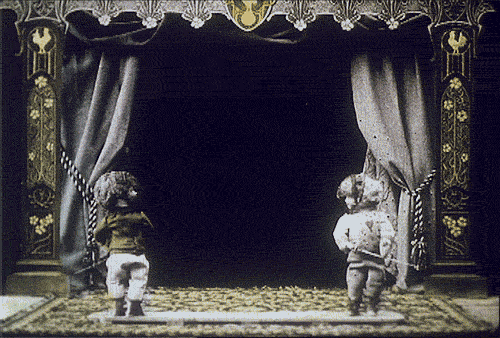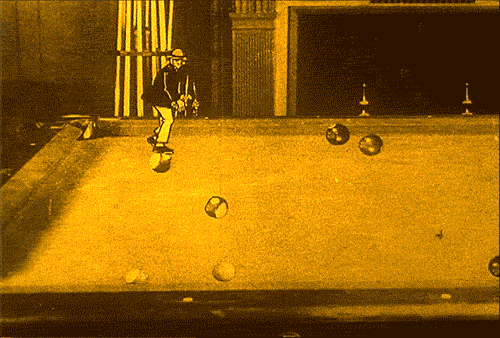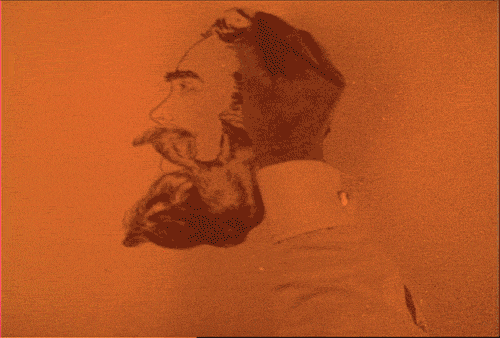Fig. 1 by University of California
Imagine a place where one might see Nixon sweating under studio lights, hear the whisper of “Rosebud” or sing along with the Mickey Mouse Club.
Such artifacts of rich cultural and artistic history are stored at the UCLA Film & Television Archive, which in less than a half century has become the second largest collection of moving pictures in the nation, surpassed only by the Library of Congress.
It is here that stacks of film canisters from the earliest years of the moving image, as well as historical newsreels, film and television broadcasts, are archived onto 35mm safety film. And it is here that researchers, students and filmmakers can access and experience this vast wealth of information and artistry, which would have otherwise melted away into oblivion.
The Silent Animation Project at UCLA exemplifies how preservation often leads to revelation. In the early years of cinema, filmmaking and animation evolved in close relation to one other, which is apparent when viewing this film compilation. It’s also fascinating, in relation to today’s filmmaking, to behold early 20th-century stop-motion magic, vibrant hand tinting and even product placement and special effects. These 11 films now are available online with historical notes, preservation commentary and commissioned music, thus bringing material from UCLA’s archive into the digital age and to a larger audience.
One interesting goal of the archival project is to showcase films outside of copyright so that viewers may reimagine and repurpose the films, adding another dimension to the interaction and helping to forge connections and create new meaning.
Highlights from the collection
 One of the earliest stop-motion puppet films is “Bob’s Electric Theatre,” made in France in 1906. The first thing the eye is drawn to is the hand-stenciled colors of the images. This color was applied by brush; the resulting effect is quite beautiful. It creates a texture along with the mottling of the nitrate film decomposition, which first took the entire third act of the so-called Electric Theatre, and finally disintegrated the entire film. The miniature staging, arranged by three young children, showcases the charming antics of puppets who perform various duels, dances, and other acrobatic acts. Although “Bob’s Electric Theatre” has the tell-tale flicker of long ago, it’s not hard to imagine how the palette of greens and golds could certainly inspire an Instagram filter today. As the shine and perfection of digital film and HD inspire an aesthetic of the analogue and retro alongside it, looking back to early film technology and artistry illuminates the trajectory and interrelation of cinema past and present.
One of the earliest stop-motion puppet films is “Bob’s Electric Theatre,” made in France in 1906. The first thing the eye is drawn to is the hand-stenciled colors of the images. This color was applied by brush; the resulting effect is quite beautiful. It creates a texture along with the mottling of the nitrate film decomposition, which first took the entire third act of the so-called Electric Theatre, and finally disintegrated the entire film. The miniature staging, arranged by three young children, showcases the charming antics of puppets who perform various duels, dances, and other acrobatic acts. Although “Bob’s Electric Theatre” has the tell-tale flicker of long ago, it’s not hard to imagine how the palette of greens and golds could certainly inspire an Instagram filter today. As the shine and perfection of digital film and HD inspire an aesthetic of the analogue and retro alongside it, looking back to early film technology and artistry illuminates the trajectory and interrelation of cinema past and present.
 When it came out in 1925, “The Lost World” awed and captivated audiences, so much so that even Houdini and the New York Times were impressed, the latter proclaiming that if the dinosaur stars were fake, they were masterpieces. “The Lost World" trailer allows audiences to see the early innovations of this film, featuring Willis O’Brien’s pioneering stop-motion effects (O’Brien went on to do “King Kong"). “The Lost World’s” impact and success not only led to other dinosaur-centric films such as “Jurassic Park,” but also was a significant precursor to our modern-day special-effect-laden action films.
When it came out in 1925, “The Lost World” awed and captivated audiences, so much so that even Houdini and the New York Times were impressed, the latter proclaiming that if the dinosaur stars were fake, they were masterpieces. “The Lost World" trailer allows audiences to see the early innovations of this film, featuring Willis O’Brien’s pioneering stop-motion effects (O’Brien went on to do “King Kong"). “The Lost World’s” impact and success not only led to other dinosaur-centric films such as “Jurassic Park,” but also was a significant precursor to our modern-day special-effect-laden action films.
 "The Lost World Promo Film” is believed to be one of the first product tie-ins, advertising a brain teaser puzzle featuring the dinosaurs of the film. The movie was released in 1925, at the height of a puzzle craze in the United States, and plans were quickly drawn up to bring the two together. While today we are all too familiar with the merchandising associated with films, watching the sincere and up-front usage of it in “The Lost World Promo Film” borders on sweet and funny compared with today’s subtler, sneakier product placement. Today, even films that don’t seem like they’d lend themselves naturally to a product tie-in still seem to find a way.
"The Lost World Promo Film” is believed to be one of the first product tie-ins, advertising a brain teaser puzzle featuring the dinosaurs of the film. The movie was released in 1925, at the height of a puzzle craze in the United States, and plans were quickly drawn up to bring the two together. While today we are all too familiar with the merchandising associated with films, watching the sincere and up-front usage of it in “The Lost World Promo Film” borders on sweet and funny compared with today’s subtler, sneakier product placement. Today, even films that don’t seem like they’d lend themselves naturally to a product tie-in still seem to find a way.
 "A Pool Plunge,” made in 1920 and originally part of a “magazine format” series of films, is a mix of live action and hand-drawn animation. In it, a group of men play a game of pool with a miniature, animated man who in turn both thwarts and assists them. The end unfortunately is lost to decomposition, but “A Pool Plunge” remains an interesting precursor to films like “Who Framed Roger Rabbit.” It’s an example of a low-budget, special effect technique that required filming the live action first, then making large photographic blow-ups of each 35mm frame. The animators would draw the cartoon character with ink on celluloid sheets, then re-photograph it all together under the camera, frame by frame.
"A Pool Plunge,” made in 1920 and originally part of a “magazine format” series of films, is a mix of live action and hand-drawn animation. In it, a group of men play a game of pool with a miniature, animated man who in turn both thwarts and assists them. The end unfortunately is lost to decomposition, but “A Pool Plunge” remains an interesting precursor to films like “Who Framed Roger Rabbit.” It’s an example of a low-budget, special effect technique that required filming the live action first, then making large photographic blow-ups of each 35mm frame. The animators would draw the cartoon character with ink on celluloid sheets, then re-photograph it all together under the camera, frame by frame.

"Animated Hair Cartoon” from 1925 is an early “trick” film, a mix of drawing and stop-motion that was a predecessor to animated films. It is actually one of a series of 51 “Animated Hair” shorts produced between 1924-27, featuring the artist’s hand and the seeming alteration of one person’s face into another. Sometimes the morphing transformation was from one famous person to another; this visual trick fascinated movie audiences.

